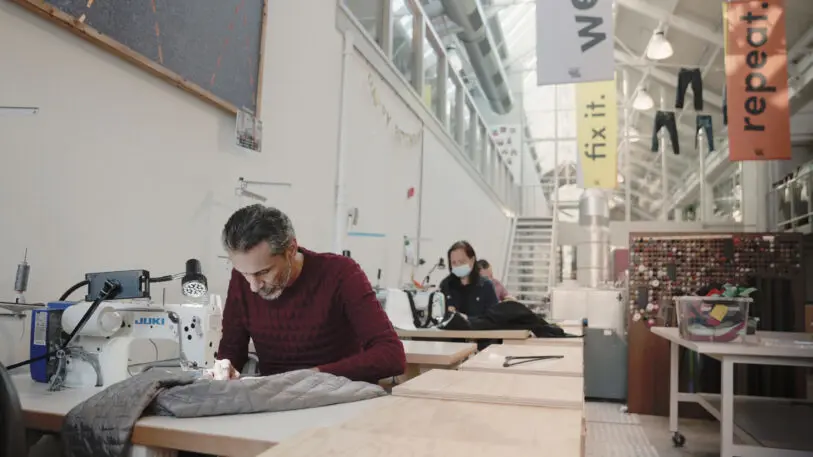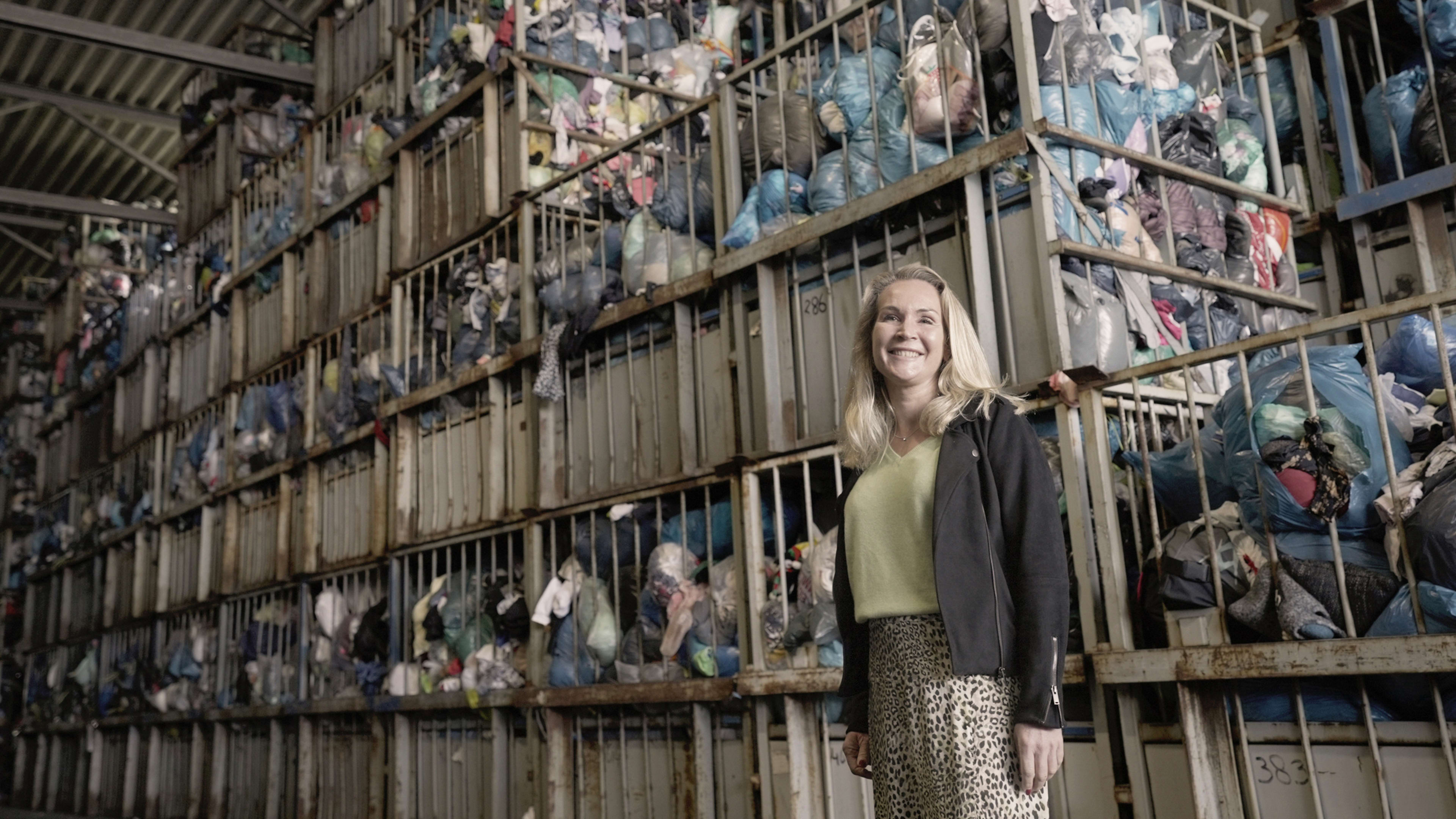If you live in Amsterdam and your shirt or jacket needs mending, the city wants to help you fix it instead of trashing it: Low-income residents can get 40% discounts at local repair shops. And if you no longer want a piece of clothing, the city hopes that you’ll take it to a place like the Swapshop, a resale store that gives discounts in exchange for each used dress or shirt you bring in. As a last resort, you can drop it off for recycling at a network of bins throughout the city. Next year, a new recycling facility will open that can turn old clothes into yarn that can be locally manufactured into clothing.
It’s one piece of the city’s approach to tackling an ambitious goal. By the middle of the century, Amsterdam aims to make its economy entirely “circular,” meaning that materials—from textiles, to solar panels, to entire buildings—are used in closed loops, instead of the current system of extracting valuable materials and using large amounts of energy to make products that quickly end up in landfills. By the end of the decade, Amsterdam plans to cut the use of nonnatural raw materials in half. But the transformation needed is huge, and it remains to be seen how far the city will get.

The City of Amsterdam, which is one of the finalists in this year’s Earthshot Prize, first unveiled its circular strategy in 2020, four years after the Dutch government set the same goals nationally. Amsterdam’s vision embraces what the British economist Kate Raworth calls the “doughnut” model of economics, which looks at both environmental and social goals. The outer edge of the doughnut represents the ecological limits of the planet, including biodiversity loss and climate breakdown. The inner ring represents basic human needs, from food to adequate housing, that everyone should be able to access. To live sustainably, society needs to exist inside both limits.
“We don’t just talk about technical solutions, or what’s the best way to [move] materials from here to there,” says Ilektra Kouloumpi from Circle Economy, the organization that helped the city build its short-term road map, including which types of waste it’s focused on reducing over the next few years. “We also talk about, ‘Hey, how can we make a city that is inclusive and just for all, while respecting the planetary boundaries?’ That has become the new vision for the City of Amsterdam.”

It still isn’t clear exactly how that long-term vision will work in practice. But multiple circular initiatives are underway. In one project, researchers are studying how concrete paving stones on streets can be recoated and reused, rather than replaced, when a road needs to be repaved. In another, they’re studying how plants that were once grown in the area—flax and hemp—could be used to make new biodegradable building materials. “We always look at, ‘Okay, how can science help?’” says Joppe van Driel, the program developer for circularity at the Amsterdam Institute for Advanced Metropolitan Solutions (AMS), an organization that connects university researchers with urban challenges, including the studies on pavement and bio-based building materials. “Different kinds of technological innovation are needed to move forward.”
Another AMS Institute study is examining how building products could be made from organic waste, and is bringing potential manufacturers and customers into the R&D process from the beginning. “When a new innovation is being developed, we try to make sure that it is being tested in a real-life environment as soon as possible,” says van Driel. The aim is to get new products to market quickly.
Construction is a major focus in the city’s strategy both because of the environmental impact of the industry and the fact that it’s an area where the city has direct control; unlike, for example, electronics that are made in China. When the city releases land for development, projects now have to meet circular criteria, including using recycled and bio-based materials and planning for future recycling or reuse. By 2025, at least one-fifth of new construction will have to use wood to replace steel, concrete, and other carbon-intensive materials.
Some circular-construction projects are already underway. One mixed-used development in progress, called Robin Wood, is made with wood and recycled aluminum. The modular design can also be adapted, so studio apartments could become larger homes or live-work units in the future. That flexibility could help the building last longer. (Longevity is a key circular strategy and considered better than recycling, since it keeps the original materials in use.) A new school is also made from wooden modules and designed to be easier to expand or later move to a different location. Another recent project fully dismantled a 14-story office building so that the parts could be reused, rather than ending up in a landfill.
The city also offers local manufacturers a free analysis that measures their impact, and what they can do differently to become more circular. Some Dutch companies have already been thinking about circularity for years, such as Fairphone, which makes smartphones that are designed to last longer than usual and can easily be disassembled for recycling. But the government’s focus on the issue can still help.
“The fact that the Dutch government has set a goal to be fully circular does help me make my point with investors and other stakeholders,” says Daan Weddepohl, founder and CEO of Peerby, a sharing platform founded in 2012 that helps neighbors borrow items like tents or tools. “It’s no longer a debate about if it will happen, merely a question of how and how soon we are going to deal with it. One would hope that the prospect of running out of natural resources would be enough to make this point, but it seems that government pressure is required before people and businesses take notice.”

Swapshop, the clothing resale shop, started hosting clothing swaps in 2018 before opening its store. “When we started, circularity was still low on the agenda. We had to shout to be heard,” says cofounder and owner Monique Drent. “When they started to realize we have a problem, and they started to look for solutions, we were there.” The city is also helping the business take the next step; it recently gave the store a grant to start a product line using materials recycled from the clothes that it can’t resell.
A range of other pilot projects are also happening. The city is scaling up its collection of food waste for composting and exploring the use of sensors on city vehicles that could automatically identify furniture at the curb and post it on an online marketplace. A new community land trust plans to use circular-construction methods. A bridge behind Amsterdam’s central train station will be dismantled and reused in another neighborhood. When the wooden floor for an indoor cycle track had to be replaced, it was made into furniture. A new measurement tool helps give different food products a score on circularity. In a city park, a café was built from materials from nearby demolition sites and local trees that had been cut down. AMS Institute also has several other pilots, including a project that is collecting old solar panels that will be reinstalled on the homes of low-income residents.
Still, all of this is happening at a small scale, and now Amsterdam has to decide which projects it wants to help grow and permanently implement. “If we keep doing all those things, everything will move a centimeter in the right direction,” says Dimitri Bak, strategic communication advisor at the City of Amsterdam. “We don’t have that time. We need to focus on several waste streams in order to get things done. That’s the new phase we’re in. . . . Now, it’s important that we make choices on which things we stop and which things we accelerate on.”
The pilots also only address a portion of the city’s cycle of consumption. Like any other city, Amsterdam is part of the global economy, and what’s happening in supply chains beyond city limits is harder to influence. Still, the city is making some efforts, as in a “denim deal” that asks some global clothing companies to commit to using more recycled material in jeans.
“You can imagine the immense collaboration between all huge businesses, international bodies, and the value chains that will need to happen to be able to create new standards for products and packaging materials so that they can loop back into the system,” says Kouloumpi. It will also require a lot of persuasion. Even in Amsterdam, arguably one of the places most attuned to the idea of a circular economy, “not everyone is on board,” she says. “And not everyone understands the value of it and the urgency for it.”
The city’s goals may be more utopian than realistic. “We cannot change our economy in a fundamental way in eight years,” says AMS Institute’s van Driel. Still, he says, goals like cutting material use in half are technically feasible. If everyone kept their phone twice as long, for example—for five years, rather than two and half—that would halve material use for those products. The materials used in construction, including carbon-intensive steel and concrete, make up around half of the total materials used in the Netherlands. “If the building sector is circular, we reach our 50% reduction goal,” he says. “That means recycling and reusing all the steel, concrete, and asphalt that we have, and substituting bio-based alternatives. If everybody does that—and it technically should be possible—then we are halfway there [to full circularity].”
Recognize your brand’s excellence by applying to this year’s Brands That Matter Awards before the final deadline, June 7.
Sign up for Brands That Matter notifications here.
